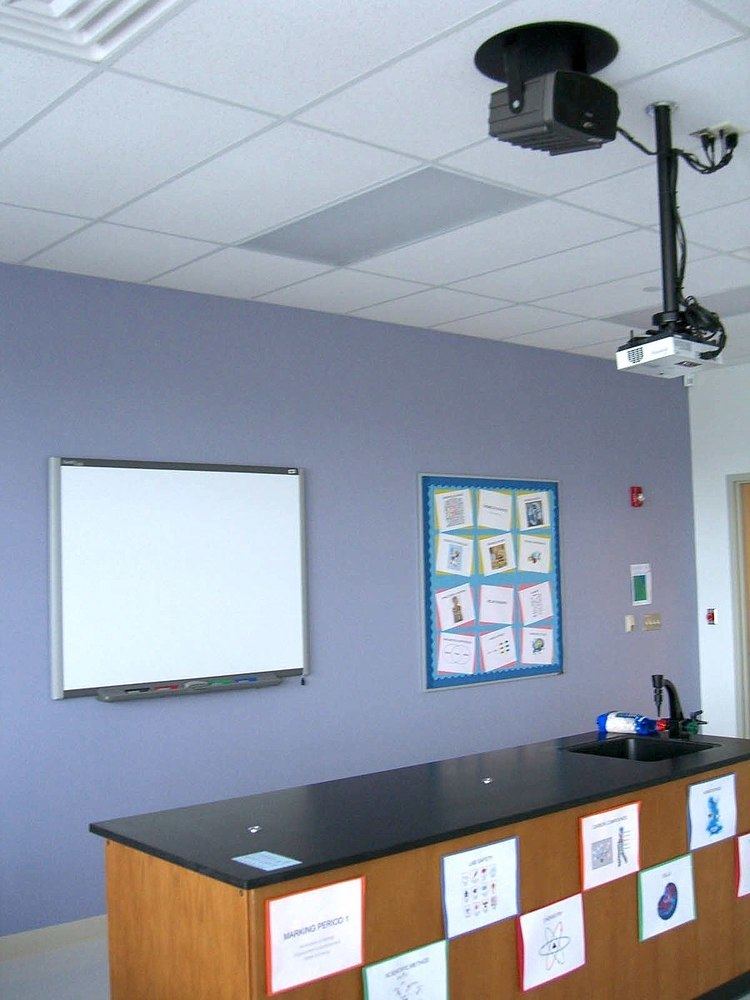Manufacturer Smart Technologies Type Interactive whiteboard Ports USB cable, VGA cable | Introduced 1991 Connection computer and DVD Weight 90 lbs. | |
 | ||
The Smart Board (stylized as "SMART Board") is a line of interactive whiteboards produced by the Calgary, Alberta-based company Smart Technologies.
Contents
History
David Martin began SMART company in 1987 as the Canadian distributor for a U.S. projector company. The revenue it collected from the projectors was put into research and development on the SMART board interactive whiteboard, which was the first interactive whiteboard to provide touch control of computer applications and the ability to write over standard Microsoft Windows applications.
The Smart Board is an interactive whiteboard that uses touch detection for user input (for example scrolling and right mouse-click) in the same way as normal PC input devices. The Smart Board 800 series interactive whiteboard introduced a 'flick and scroll' feature.
In December 2010, Smart introduced the lower-cost Smart Board 400 series interactive whiteboard.
Technology
The Smart Board interactive whiteboard operates as part of a system that includes the interactive whiteboard, a computer, a projector and whiteboarding software - either Smart Notebook collaborative learning software for education, or Smart Meeting Pro software for business. The components are connected wirelessly or via USB or serial cables. A projector connected to the computer displays the desktop image on the interactive whiteboard. The whiteboard accepts touch input from a finger, pen or other solid object. Smart Board interactive whiteboards are also available as a front-projection flat-panel display – interactive surfaces that fit over plasma or LCD display panels.
Pen tray
Most models of Smart Board include a pen tray on the front of the interactive whiteboard that holds two to four plastic pen tools and an eraser. The pen tools have neither electronic components nor ink - the technology is in the pen tray. When a pen tool is removed from its slot in the tray, an optical sensor recognizes its absence. The Smart Board software processes the next contact with the interactive whiteboard surface as a pen action from the pen tool that resides in the corresponding slot. Older models of the Smart Board interactive whiteboard features slots for black, blue, red and green pen tools, although a control panel can be used to change the color of the digital ink or change the pen tools to colored highlighters.
Resistive technology
The older Smart Board 600 series interactive whiteboards use resistive technology. A flexible plastic front sheet and hard backboard are coated with a thin resistive film. The resistive sides of each are separated by an air gap of two-thousandths of an inch, or about the width of two human hairs. Pressure applied to the surface of the front sheet closes the gap and is registered as a contact point. This contact point is then converted from an analog signal to a serial data stream which is sent to a computer for further processing. This technology can process contact from a finger, pen tool or any device – such as a pointer.
Software
Smart Notebook software is included with the Smart Board and allows users to compile notes, images, and other media into virtual notebooks which can be projected and edited using the Smart Board itself. Smart Product Drivers are required for the Smart Board to work properly. Other Smart software products, like Smart Response interactive response, the Smart Document Camera, Smart Ideas concept-mapping software, Smart Notebook Math Tools and Smart Slate wireless slate are designed for use.
The Smart Board interactive whiteboard works with any program loaded or available on the host computer. Some applications commonly used with the Smart Board are Microsoft PowerPoint, Excel, Word, and AutoCAD.
Uses
Uses for the Smart Board include teaching, training, conducting meetings, and delivering presentations. It has also been used on the Discovery Channel television show MythBusters.
In Datacloud: Toward a New Theory of Online Work, Johndan Johnson-Eilola describes a specific computer-supported space for collaboration: the Smart Board. According to Johnson-Eilola, a “Smart Board [interactive whiteboard] system provides an... intelligent whiteboard surface for work” (79). Johnson-Eilola asserts that “[w]e are attempting to understand how users move within information spaces, how users can exist within information spaces rather than merely gaze at them, and how information spaces must be shared with others rather than being private, lived within rather than simply visited” (82). He explains how the Smart Board interactive whiteboard system offers an information space that allows his students to engage in active collaboration. He makes three distinct claims regarding the functionality of the technology: 1) the Smart Board allows users to work with large amounts of information, 2) it offers an information space that invites active collaboration, and 3) the work produced is often “dynamic and contingent” (82).
